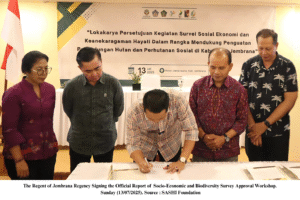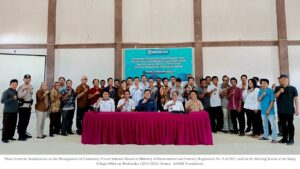Since mid-2022, SASHI Foundation in collaboration with Forum Musyawarah Masyarakat Adat (FOMMA) and supported by Yayasan Konservasi Alam Nusantara (YKAN), has facilitated Masyarakat Hukum Adat Dayak Tahol in Putat, Seruyung and Salap villages to get their forests recognized.
Since the Constitutional Court decision Number 35/PUU-X/2012, customary forests are no longer part of state forest areas, but instead become a private forests. Kementerian Lingkungan Hidup dan Kehutanan (KLHK) then issued Decree No. P.32/Menlhk-Setjen/2015 concerning Private Forests which states that customary forests are private forests. Then Government Regulation no. 23 of 2021 concerning Forestry Implementation clearly defines forest areas as consisting of state forests and customary forests, and based on their status, forests consist of state forests, customary forests and private forests (Article 15).
Article 233 states that customary forests are managed by Masyarakat Hukum Adat (MHA), can originate from state forests and/or non-state forests, and have the main functions of conservation, protection and/or production. Confirmation of the existence of MHA in state forest areas is determined by Regional Regulation (Perda), while the existence of MHA outside forest areas is determined by Regional Regulation or a decision of the governor or regent/mayor in accordance with their authority. If the Regional Regulation only regulates the substance of procedures for recognizing MHA, then the confirmation of the existence of MHA is determined by a decision of the governor or regent/mayor in accordance with their authority (Article 234).
Furthermore, the determination of the status of a Customary Forest is carried out through an application to the Minister by the customary holder (Article 238) and after the determination it will be removed from the State Forest (Article 237). If there is no regional regulation (Perda), but there is a determination of a Customary Area by decision of the regent/mayor, then the Minister carries out the process of determining the Indicative Customary Forest Area or “WIHA”, where the determination of Customary Forest status follows the existence of the Perda (Article 239). Furthermore, Article 239 states, if WIHA has not been issued a utilization permit, the government will not issue a permit in that area. Meanwhile, if WIHA already has a utilization permit, the permit holder’s activities are adjusted to Local Wisdom and coordinated with relevant traditional stakeholders. The determination of Customary Forests is regulated more fully in Minister of Environment and Forestry Regulation Number 9 of 2021 concerning Social Forestry Management.
The Malinau Regency Government has issued Regional Regulation no. 10 of 2012 concerning Recognition and Protection of the Rights of Indigenous Peoples in Malinau Regency. This regulation regulates the substance of indigenous peoples’ rights, institutions, processes and forms of legal recognition, dispute resolution and government responsibilities. Article 18 states the establishment of the Indigenous Community Affairs Management Agency/BPUMA, which currently operates based on Regent Regulation No. 201/2014. BPUMA then issued guidelines for the process of establishing customary territories in Malinau Regency.
SASHI facilitated the process of confirming the Dayak Tahol traditional territory in the villages of Putat, Seruyung and Salap to obtain a decree from the Regent of Malinau. SASHI will continue to support these communities to promote community-based forest management in the near future.







